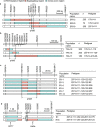Rice Flowering Locus T 1 plays an important role in heading date influencing yield traits in rice
- PMID: 28687802
- PMCID: PMC5501849
- DOI: 10.1038/s41598-017-05302-3
Rice Flowering Locus T 1 plays an important role in heading date influencing yield traits in rice
Abstract
Important role of flowering genes in enhancing grain productivity in rice has become well recognized for a number of key genes regulating the florigen production, but little has been known for the two florigen genes themselves. In this study, pleiotropism of Rice Flowering Locus T 1 (RFT1), one of the two florigen genes in rice, was firstly evaluated using near isogenic lines (NILs) carrying RFT1 alleles from the indica rice cultivars Zhenshan 97 (ZS97) and Milyang 46, respectively, and then determined by transformation of the RFT1 ZS97 allele into a japonica rice variety, Zhonghua 11. The RFT1 ZS97 allele was shown to delay heading and increase plant height, grain weight, grain number and grain yield, indicating that RFT1 plays an important role in the growth and development of rice. This study has also validated the potential of using a new type of genetic resource, sequential residual heterozygotes (SeqRHs), for QTL fine-mapping. A step-by-step approach was employed for SeqRHs identification, NIL development and QTL fine-mapping. The heterozygous segments and candidate QTL regions were gradually narrowed down. Eventually, the QTL region was delimited to a 1.7 kb region containing a single gene.
Conflict of interest statement
The authors declare that they have no competing interests.
Figures



Similar articles
-
Pleiotropic Effects of Rice Florigen Gene RFT1 on the Amino Acid Content of Unmilled Rice.Front Genet. 2020 Jan 31;11:13. doi: 10.3389/fgene.2020.00013. eCollection 2020. Front Genet. 2020. PMID: 32076435 Free PMC article.
-
Fine mapping of qHd1, a minor heading date QTL with pleiotropism for yield traits in rice (Oryza sativa L.).Theor Appl Genet. 2014 Nov;127(11):2515-24. doi: 10.1007/s00122-014-2395-7. Epub 2014 Sep 16. Theor Appl Genet. 2014. PMID: 25223543 Free PMC article.
-
Natural variation at qHd1 affects heading date acceleration at high temperatures with pleiotropism for yield traits in rice.BMC Plant Biol. 2018 Jun 7;18(1):112. doi: 10.1186/s12870-018-1330-5. BMC Plant Biol. 2018. PMID: 29879910 Free PMC article.
-
Genetic manipulation and quantitative-trait loci mapping for nitrogen recycling in rice.J Exp Bot. 2002 Apr;53(370):917-25. doi: 10.1093/jexbot/53.370.917. J Exp Bot. 2002. PMID: 11912234 Review.
-
Yield-related QTLs and their applications in rice genetic improvement.J Integr Plant Biol. 2012 May;54(5):300-11. doi: 10.1111/j.1744-7909.2012.01117.x. J Integr Plant Biol. 2012. PMID: 22463712 Review.
Cited by
-
A Pleiotropic Flowering Time QTL Exhibits Gene-by-Environment Interaction for Fitness in a Perennial Grass.Mol Biol Evol. 2022 Oct 7;39(10):msac203. doi: 10.1093/molbev/msac203. Mol Biol Evol. 2022. PMID: 36149808 Free PMC article.
-
Heterosis Derived From Nonadditive Effects of the BnFLC Homologs Coordinates Early Flowering and High Yield in Rapeseed (Brassica napus L.).Front Plant Sci. 2022 Feb 15;12:798371. doi: 10.3389/fpls.2021.798371. eCollection 2021. Front Plant Sci. 2022. PMID: 35251061 Free PMC article.
-
Development and verification of SSR markers from drought stress-responsive miRNAs in Dongxiang wild rice (Oryza rufipogon Griff.).Funct Integr Genomics. 2022 Dec;22(6):1153-1157. doi: 10.1007/s10142-022-00891-3. Epub 2022 Aug 2. Funct Integr Genomics. 2022. PMID: 35916988
-
A single nucleotide deletion in the third exon of FT-D1 increases the spikelet number and delays heading date in wheat (Triticum aestivum L.).Plant Biotechnol J. 2022 May;20(5):920-933. doi: 10.1111/pbi.13773. Epub 2022 Jan 29. Plant Biotechnol J. 2022. PMID: 34978137 Free PMC article.
-
Transcriptome Profiling of Spike Development Reveals Key Genes and Pathways Associated with Early Heading in Wheat-Psathyrstachys huashanica 7Ns Chromosome Addition Line.Plants (Basel). 2025 Jul 7;14(13):2077. doi: 10.3390/plants14132077. Plants (Basel). 2025. PMID: 40648086 Free PMC article.
References
-
- Khush GS. Strategies for increasing the yield potential of cereals: case of rice as an example. Plant Breeding. 2013;132:433–436.
-
- Liang S, et al. Usefulness of the cloned and fine-mapped genes/QTL for grain yield and related traits in indica rice breeding for irrigated ecosystems. Field Crops Res. 2016;187:58–73. doi: 10.1016/j.fcr.2015.11.014. - DOI
Publication types
MeSH terms
LinkOut - more resources
Full Text Sources
Other Literature Sources

